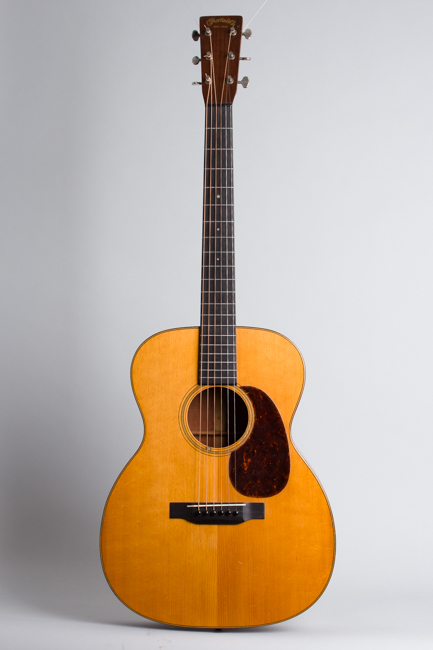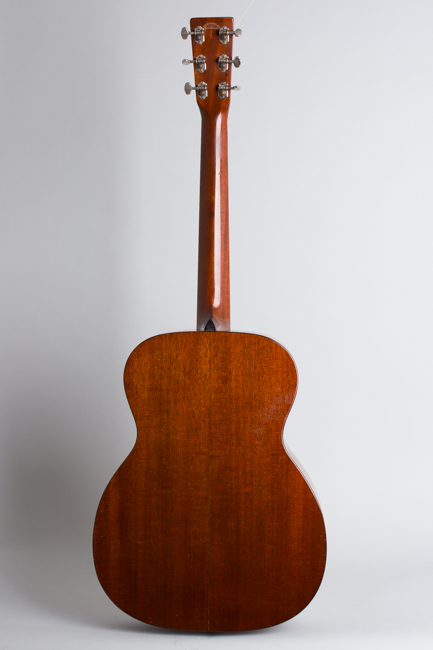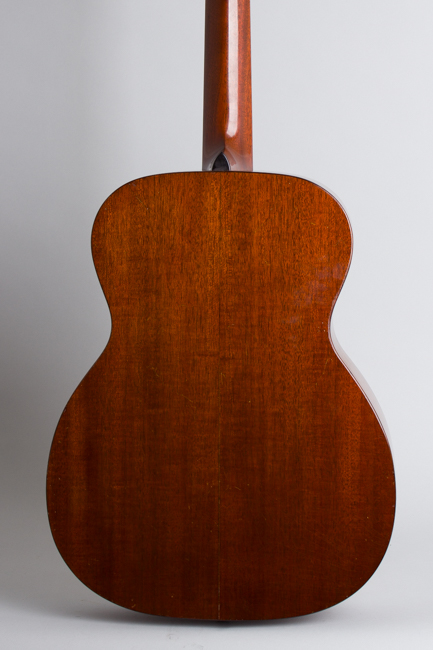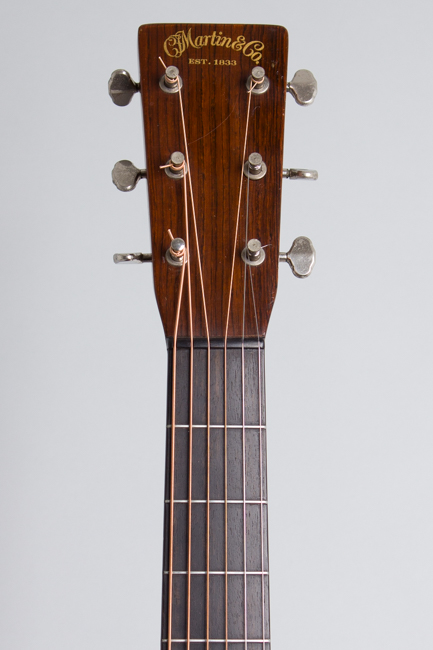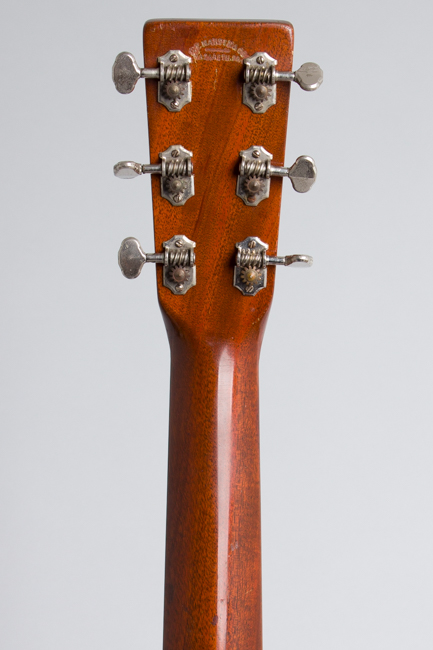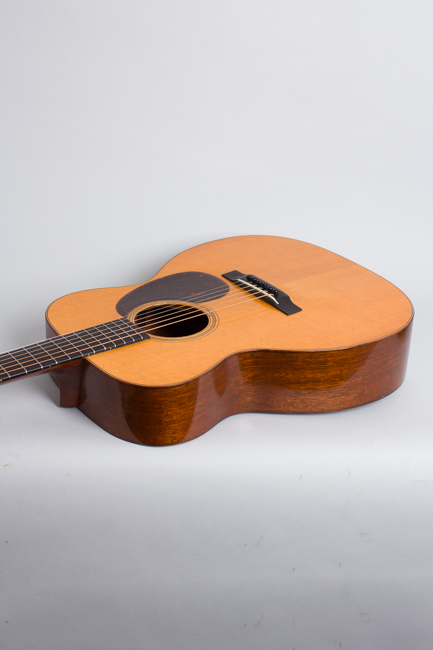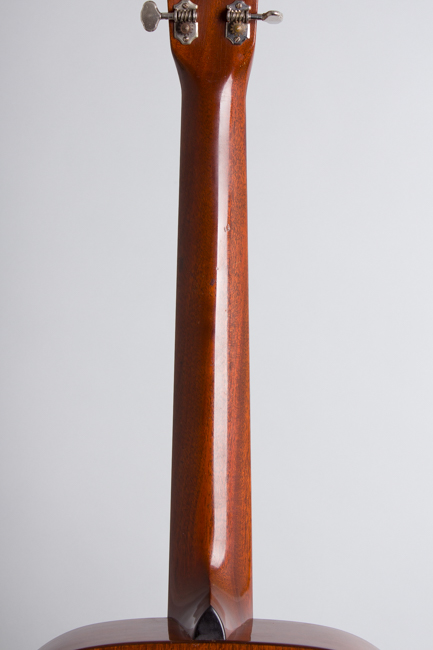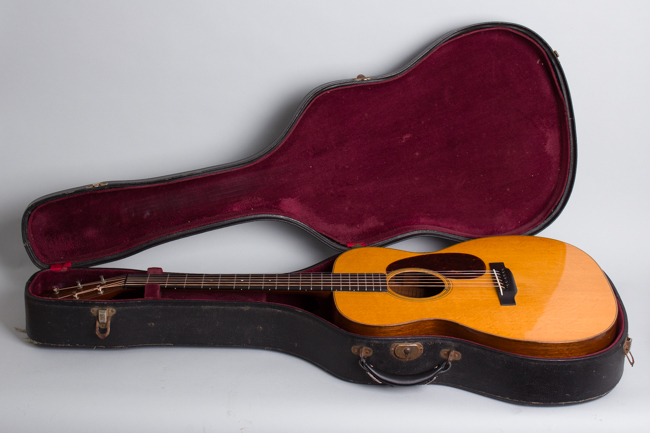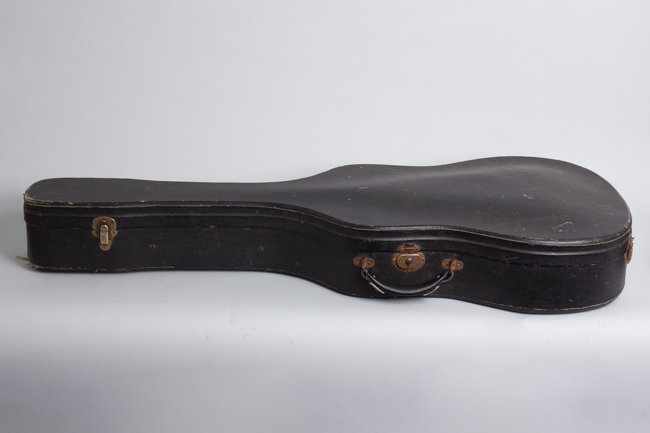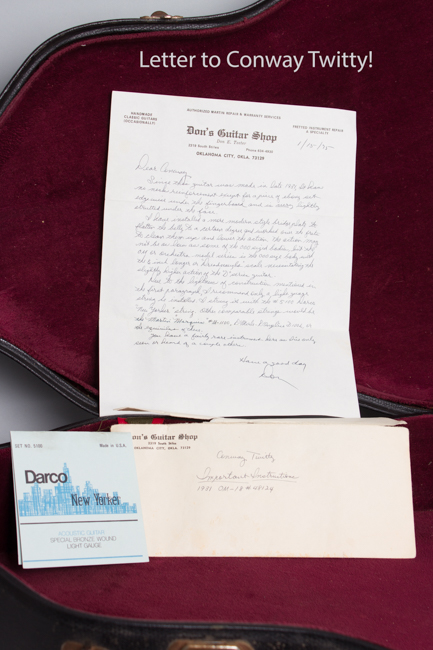C. F. Martin OM-18 Previously Owned By Conway Twitty Flat Top Acoustic Guitar (1931)
C. F. Martin OM-18 Previously Owned By Conway Twitty Model Flat Top Acoustic Guitar (1931), made in Nazareth, PA, serial # 48124, natural lacquer finish, mahogany back, sides and neck, spruce top; ebony fingerboard, original black hard shell case.
This beautiful original Martin OM-18 has accrued a story since its birth in Nazareth Pa. in late 1931. Surviving beautifully through the decades, it spent some in the possession of Country legend Conway Twitty. It was worked on (for Twitty) in the '70s by well known luthier Don Teeter, documented by a letter in the case dated to January 1975 advising on care and string gauges. In 2003 the guitar was re-worked at Gruhn's in Nashville, restored to its original state with what OM guru Eric Schoenberg described as "forgery grade" bridge and bridge plate. It has had some travels since, appearing on several well known vintage websites. We can say with the guitar in hand is this is simply one of the best sounding OM-18's we have heard; powerful yet sweet and authoritative when pushed.
The OM-18 is one of the most iconic of all flat-top guitars representing (along with the rosewood OM-28) the first flowering of the "Modern" American steel-string flat top. The combination of a 14-fret, long scale neck with a shortened 000 sized body created a new paradigm of guitar construction that has been revered (and imitated) ever since. Throw in the delicately scalloped "advanced" early 1930s X-braced top and you get the full measure of "golden age" Martin glory. This OM-18's 15" wide narrow-waisted light mahogany body and scallop-braced spruce top coupled with the longer scale neck make for a warm and superbly responsive guitar.
Originally conceived for Atlanta banjoist/guitarist Perry Bechtel the ground-breaking 14-fret rosewood OM-28 first appeared in late 1929. The mahogany-bodied OM-18 followed in early 1930 and proved an immediate success, even as the depression set in. The design was so well received that after 1933 nearly all Martin guitars switched to the "Orchestra Model" format. The OM-18 designation was dropped and this 14-fret model simply called the 000-18, a company mainstay ever since. Martin made an important change soon after by shortening the scale, leaving the original 1930-33 OM-18 to become one of the most sought-after of all mahogany Martins.
In one of those great fretted ironies Martin catalogs described OM models as "designed for plectrum playing in orchestra work" but they have become renowned as the greatest fingerstyle guitar ever built. In another vein OM's quickly became popular with hard-strumming cowboy, recording and radio entertainers. Since the early 1930's the OM has been celebrated as one of Martin's crowning achievements, among the greatest flat tops ever created.
This OM-18 was built late in 1931, with several new features for the time. It would be one of the first OMs mounting the then-new Grover single unit guitar machines instead of banjo pegs which proved unreliable at best. It also has the second style tortoise celluloid pickguard, a bit larger than first version. The soft "V" profile neck has a 1 3/4" nut width and is fitted with bar frets, phased out a couple of years later. The headstock face carries the newly added earliest silkscreened "C.F. Martin" logo, a new addition with the small Martin stamp on the headstock rear retained.
Martin produced only 251 OM-18's in 1930, the peak production year. Introduced at $60 in 1930, it was quickly reduced to a rock-bottom $50 in 1931 and '32; Martin had to make guitars affordable in the Depression's hardest years! At the time this OM was a distinctly modern guitar design, still built with the exemplary craftsmanship of Martin's 19th century traditions.
While revered more for his fabulous voice (and amazing hair!) than his guitar playing, Conway Twitty did own some nice vintage Martins. His untimely death in 1993 led to a messy estate situation and the bulk of his possessions were sold at auction not long after. This fabulous guitar looks to have been well cared for along the way and in a few more years will enter its second century soon enough. This first-generation OM-18 remains a superb instrument, in cleaner, more original condition than many and a joy to play and to hear.
Overall length is 40 in. (101.6 cm.), 15 1/8 in. (38.4 cm.) wide at lower bout, and 4 1/8 in. (10.5 cm.) in depth at side, taken at the end block. Scale length is 25 1/4 in. (641 mm.). Width of nut is 1 3/4 in. (44 mm.).
This guitar is not absolutely pristine but for a 90+ year old instrument as delicately built as this the condition is exemplary; few original OM-18s have survived in this state of preservation. As noted work was done on the instrument for Twitty in the mid-70s; some of this was un-done in 2003 when a very detailed restoration of the bridge and bridgeplate were undertaken at Gruhn's. Both are now accurate replicas of the original 1931 style pieces, the bridgeplate being a VERY small slim piece of maple just like the original. The delicate internal scalloped bracing is completely intact, with a couple of small spots appearing to have been reglued at some point.
The finish appears all original with the exception of some very old thin overspray to the bottom sides either side of the endpin. A couple of spots were worn through the finish under this, with what look like very small grain crack repairs visible from the inside. There are also two small and practically invisible hairline grain splits repaired on the lower side waist. Other than these the instrument is amazingly crack free, which with a thin top like this is extremely gratifying. The otherwise original finish is quite well preserved with some dings and scratches here and there but little of the common pickwear to the top. The bottom rim of the soundhole shows the only notable wear into the wood. A small discolored spot on the soundhole edge below the E/A strings may be a cigarette burn; there does not appear to be any overspray or repair in this area.
The neck has been neatly reset (minor touchup to the heel is visible under blacklight) and the original bar frets crowned a bit. The original first-generation riveted gear Grover tuners still work well; the low E string machine is a near-identical correct period replacement; the broken original is still in the case pocket along with a 1930s cord strap. The instrument plays superbly and the sound is fantastically detailed -- not only is this one of the flat-out louder OM-18s we have heard, but it responds immediately and every note shimmers with a life of its own. With a great history behind it this is simply a fantastic example of one of the most sought-after of all flat-top guitars, truly a Martin for the ages. To top it off it still resides in the even rarer original HSC, solid with some external wear and a replaced handle. Overall Excellent Condition.
This beautiful original Martin OM-18 has accrued a story since its birth in Nazareth Pa. in late 1931. Surviving beautifully through the decades, it spent some in the possession of Country legend Conway Twitty. It was worked on (for Twitty) in the '70s by well known luthier Don Teeter, documented by a letter in the case dated to January 1975 advising on care and string gauges. In 2003 the guitar was re-worked at Gruhn's in Nashville, restored to its original state with what OM guru Eric Schoenberg described as "forgery grade" bridge and bridge plate. It has had some travels since, appearing on several well known vintage websites. We can say with the guitar in hand is this is simply one of the best sounding OM-18's we have heard; powerful yet sweet and authoritative when pushed.
The OM-18 is one of the most iconic of all flat-top guitars representing (along with the rosewood OM-28) the first flowering of the "Modern" American steel-string flat top. The combination of a 14-fret, long scale neck with a shortened 000 sized body created a new paradigm of guitar construction that has been revered (and imitated) ever since. Throw in the delicately scalloped "advanced" early 1930s X-braced top and you get the full measure of "golden age" Martin glory. This OM-18's 15" wide narrow-waisted light mahogany body and scallop-braced spruce top coupled with the longer scale neck make for a warm and superbly responsive guitar.
Originally conceived for Atlanta banjoist/guitarist Perry Bechtel the ground-breaking 14-fret rosewood OM-28 first appeared in late 1929. The mahogany-bodied OM-18 followed in early 1930 and proved an immediate success, even as the depression set in. The design was so well received that after 1933 nearly all Martin guitars switched to the "Orchestra Model" format. The OM-18 designation was dropped and this 14-fret model simply called the 000-18, a company mainstay ever since. Martin made an important change soon after by shortening the scale, leaving the original 1930-33 OM-18 to become one of the most sought-after of all mahogany Martins.
In one of those great fretted ironies Martin catalogs described OM models as "designed for plectrum playing in orchestra work" but they have become renowned as the greatest fingerstyle guitar ever built. In another vein OM's quickly became popular with hard-strumming cowboy, recording and radio entertainers. Since the early 1930's the OM has been celebrated as one of Martin's crowning achievements, among the greatest flat tops ever created.
This OM-18 was built late in 1931, with several new features for the time. It would be one of the first OMs mounting the then-new Grover single unit guitar machines instead of banjo pegs which proved unreliable at best. It also has the second style tortoise celluloid pickguard, a bit larger than first version. The soft "V" profile neck has a 1 3/4" nut width and is fitted with bar frets, phased out a couple of years later. The headstock face carries the newly added earliest silkscreened "C.F. Martin" logo, a new addition with the small Martin stamp on the headstock rear retained.
Martin produced only 251 OM-18's in 1930, the peak production year. Introduced at $60 in 1930, it was quickly reduced to a rock-bottom $50 in 1931 and '32; Martin had to make guitars affordable in the Depression's hardest years! At the time this OM was a distinctly modern guitar design, still built with the exemplary craftsmanship of Martin's 19th century traditions.
While revered more for his fabulous voice (and amazing hair!) than his guitar playing, Conway Twitty did own some nice vintage Martins. His untimely death in 1993 led to a messy estate situation and the bulk of his possessions were sold at auction not long after. This fabulous guitar looks to have been well cared for along the way and in a few more years will enter its second century soon enough. This first-generation OM-18 remains a superb instrument, in cleaner, more original condition than many and a joy to play and to hear.
Overall length is 40 in. (101.6 cm.), 15 1/8 in. (38.4 cm.) wide at lower bout, and 4 1/8 in. (10.5 cm.) in depth at side, taken at the end block. Scale length is 25 1/4 in. (641 mm.). Width of nut is 1 3/4 in. (44 mm.).
This guitar is not absolutely pristine but for a 90+ year old instrument as delicately built as this the condition is exemplary; few original OM-18s have survived in this state of preservation. As noted work was done on the instrument for Twitty in the mid-70s; some of this was un-done in 2003 when a very detailed restoration of the bridge and bridgeplate were undertaken at Gruhn's. Both are now accurate replicas of the original 1931 style pieces, the bridgeplate being a VERY small slim piece of maple just like the original. The delicate internal scalloped bracing is completely intact, with a couple of small spots appearing to have been reglued at some point.
The finish appears all original with the exception of some very old thin overspray to the bottom sides either side of the endpin. A couple of spots were worn through the finish under this, with what look like very small grain crack repairs visible from the inside. There are also two small and practically invisible hairline grain splits repaired on the lower side waist. Other than these the instrument is amazingly crack free, which with a thin top like this is extremely gratifying. The otherwise original finish is quite well preserved with some dings and scratches here and there but little of the common pickwear to the top. The bottom rim of the soundhole shows the only notable wear into the wood. A small discolored spot on the soundhole edge below the E/A strings may be a cigarette burn; there does not appear to be any overspray or repair in this area.
The neck has been neatly reset (minor touchup to the heel is visible under blacklight) and the original bar frets crowned a bit. The original first-generation riveted gear Grover tuners still work well; the low E string machine is a near-identical correct period replacement; the broken original is still in the case pocket along with a 1930s cord strap. The instrument plays superbly and the sound is fantastically detailed -- not only is this one of the flat-out louder OM-18s we have heard, but it responds immediately and every note shimmers with a life of its own. With a great history behind it this is simply a fantastic example of one of the most sought-after of all flat-top guitars, truly a Martin for the ages. To top it off it still resides in the even rarer original HSC, solid with some external wear and a replaced handle. Overall Excellent Condition.
